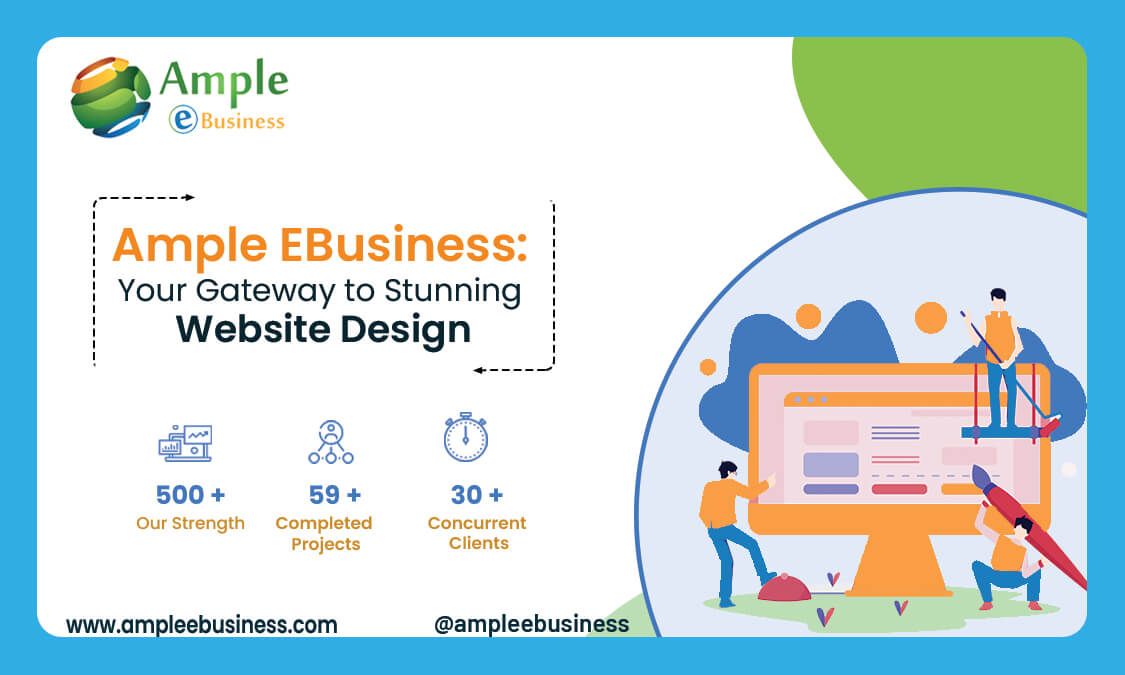
What is a good website?
An appealing and well-designed website increases engagement, enhances the user experience, and makes a favourable first impression on visitors. But if you’re just getting started, you might need assistance in order to comprehend what makes a great website or how to create a website in the first place.
Therefore, we will investigate what aspects of a website, from its fundamental structure to its sophisticated functionality, constitute good design. For a better understanding of how to create an interesting and user-friendly website, we have curated this article for you to understand the concept easily.
What Makes a Good Website? Your Gateway to Stunning Website Design
The following section provides a list of important factors to think about when creating your first website.
1) Design
The way users interact with the content on a website is determined by its design, which makes an important first impression. Because of this, more companies are hiring qualified web designers to improve the look of their websites so that they can stand out from their rivals and draw in more customers.
Here are a few web design best practises to keep in mind as you create a fantastic website:
a) Utilise eye-catching colour schemes
Colours in website design elicit feelings from viewers, add visual interest, and grab their attention. Learn the fundamental principles, themes, and guidelines of colour theory so you can create a colour scheme that supports the objectives of your brand’s identity.
When designing a website, think about using online colour palette generators like Adobe Colour to help speed up the procedure.
b) Select the correct fonts
The usability and accessibility of a site can suffer from poor font choices. To ensure the typography is compatible with various devices and web browsers, it is best to use web-safe fonts like Arial, Times, and Helvetica.
To increase readability and make the text more visually appealing, choose the proper font sizes and spacing.
c) Establish a visible hierarchy
Plan the placement of all website components so that users can quickly find and navigate to the important pages.
There are many ways to create a visual hierarchy on your website, such as using grids and whitespace to organise the layout or using colour, proportion, and contrast to emphasise particular elements.
2) Functionality
Every website has a different function. For instance, eCommerce websites are created to offer users a seamless online shopping experience. On the other hand, the primary objective of a business website is to present details about the company and its goods or services in a professional and user-friendly manner in order to increase sales and revenue.
Determining a website’s goals and purpose before it is actually built is crucial for this reason. To do this, decide who your target audience is and what kind of features and content they require.
3) Features
To increase usability, every contemporary website should have these crucial features:
a) A headline that is clear and compelling: The website’s headline should describe its content and entice visitors to look around.
b) Hero photo or movie: The website’s message or theme should be supported by the hero image or video, which should be a standout component.
c) Menu for navigating: The navigation menu should be easily accessible, prominently displayed, and clearly labelled for each section and page.
d) CTA (call to action) buttons: These buttons should be prominently displayed in order to entice users to perform certain actions, like making a purchase or subscribing to a newsletter.
e) Social evidence: To increase credibility and trust, social proof components can be added, such as client testimonials or partner badges.
f) Concise and clear content: The writing should be simple to read and comprehend, with consistent and clear messaging.
g) Videos and pictures: Images and videos that help break up text and provide additional information should be included on a good website.
4) SEO
In addition to offering a good website design, search engine optimisation (SEO) should be used to raise the ranking of your website on search engines.
Following these best practices will help you create websites that are search engine-friendly:
a) Keyword research: Finding the best keywords to target is crucial for a successful SEO strategy, according to keyword research. A website can make sure that the right people see it by conducting research and choosing the appropriate keywords.
b) Technical optimisation: Technical optimisation makes sure a website is set up correctly for search engine indexing. This includes making sure the website loads quickly, has no broken links and is responsive to mobile devices. In order to track website performance, technical optimisation also entails setting up and configuring web analytics.
c) Create quality backlinks: Build high-quality backlinks from trustworthy websites to increase the authority and ranking of your website.
d) Content improvement: This includes developing keyword-rich content with words and ideas that are conceptually related. Making sure that content is well-structured, using heading tags and other HTML components to make it simpler for search engines to crawl and index the page, is another aspect of content optimisation.
5) User encounter
The process of designing a website with users’ needs and preferences in mind is known as user experience (UX). It entails comprehending the objectives, problems, and behaviours of your target audience and using that knowledge to create a user-friendly website.
Customers will stay engaged and believe their journey is simple if the UX design is effective. By utilising design principles like clear visuals, concise copy, and logical navigation, businesses can guarantee that their clients will have a positive experience and move forward in the sales process.
The website for Amazon is a great illustration of how UX design can direct customers to make a purchase.
6) Adaptive Design
A web design strategy known as responsive design enables your website to adapt its layout depending on the device being used to view it.
This guarantees that the website looks fantastic and performs properly on all devices, including desktops, laptops, and mobile phones. The user experience can be enhanced by responsive and mobile-friendly design because users can easily interact with the content on any device.
7) Organised Data
Website owners can provide pertinent information about content, such as site categories, publication dates, and metadata, by using structured data.
Search engines can quickly understand the context of content when a website contains structured data, which can increase search traffic to your website.
For instance, if a website contains structured data for a recipe, the website is qualified to display content-rich snippets in the SERP that can include information like the recipe’s rating, cooking time, and serving size.
8) Current Content
To ensure a positive user experience, a great website must remain current. A website’s user experience and potential security holes will both be improved by routine updates.
A website that is frequently updated lets users know about new features, which encourages them to come back. Additionally, it guarantees that the users’ data is secure and that it is compatible with the most recent devices and web browser versions.
9) Clearly state the value
The best websites frequently present a distinct value proposition to help you stand out from the competition and win over the trust and credibility of potential customers.
List the advantages of your goods or services and how they address the problems of your target market in order to create a clear value proposition.
Include compelling justifications for why your offering is superior to that of the opposition, and draw attention to the distinctive elements and features of your website. This could be something unique about your website, like a customised customer service experience or a wide range of goods.
10) Excellent visuals
The majority of outstanding websites use good graphics to enhance the site’s overall appearance and user experience. Avoid using stock photos, as they will make your website appear unimpressive and amateurish.
Instead, website owners ought to use unique, premium images that are pertinent to their online presence and are consistent with their branding and messaging.
Conclusion
Design, navigation, search engine optimisation, and user experience are just a few of the many aspects that need to be carefully taken into account when building a good website.
These suggestions will assist you in developing an efficient and interesting website for your audience, regardless of whether you are an experienced web developer or a first-time website creator.
In conclusion, keep in mind that a website should be simple to use, aesthetically pleasing, and offer users useful content to be considered a good website.
You may contact us, Ample eBusiness, to avail of our services.

